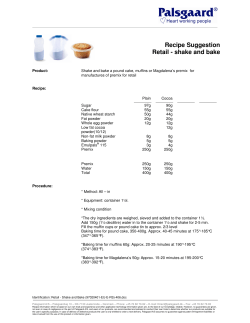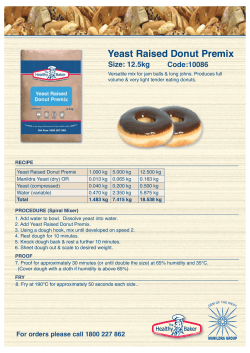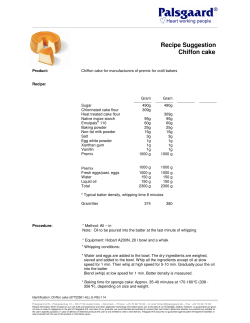
Duplex Real-Time RT-PCR Reagent Set for Porcine Epidemic Diarrhea
Duplex Real-Time RT-PCR Reagent Set for Porcine Epidemic Diarrhea Virus (PEDV) and Swine Deltacoronavirus (SDCV) For Research use only I. Background Porcine epidemic diarrhea virus (PEDV) was first recognized in the US in May 2013. Since then, PEDV has been detected in at least 27 states in the US and in Canada and caused significant loss to pig industry. Swine deltacoronavirus (SDCV) was first reported in Hong Kong in 2012. In the beginning of 2014, SDCV was first detected in fecal and intestine samples from pigs experienced diarrheal disease in pig farms in Ohio. The duplex real-time RT-PCR is designed to detect the PEDV and SDCV from fecal samples. This assay may also be used for detection of both viruses in oral fluid samples. The detection limit of the PCR is one copy for cloned gene targets of both viruses. II. System Components: stored at 4°C Real-Time RT-PCR PEDV/SDCV Reagent Set Cat no.: areal-pedv/sdcv Number of reactions: 48 reactions Component Amount Contents Enzyme/dNTP Pack 1 zip-lock pack, 6 lyophilized tubes/pack, (One premix pellet for 9 reactions in a 0.6 ml tube) Taq DNA polymerase, MMLV RTase, RNase inhibitor, and dNTPs Real-Time RT-PCR Reagent PEDV/SDCV Primer/Probe Pack 1 zip-lock pack, 6 lyophilized tubes/pack, (One premix pellet for 9 reactions in a 0.6 ml tube) Specific primers and fluorescent probes PEDV/SDCV Positive Control Dry pellet, 1 vial Dry pellet containing PEDV and SDCV positive controls P(+) Control Buffer 110 μl/vial, 1 vial Reaction buffer to redissolve the PEDV and SDCV Positive Control 1.25X Premix Buffer Set 500 μl/vial, 3 vials Reaction buffer 1 III. Amplification Reaction Protocol A. Reaction procedure: Note: Prepare 9-fold volumes of master mix for 8 reactions. The amount of excess is for pipetting error. 1. Have Enzyme/dNTP tubes ready according to the sample number to be tested. Note: When the Enzyme/dNTP pellet is not found at the bottom, please spin it down. 2. Add 180 μl 1.25X Premix Buffer into each premix tube and mix well. 3. Transfer 180 μl of the dissolved mixture into each Primer/Probe tube. 4. Bring total volume of each Primer/Probe/Premix mixture to 202.5 μl with ddH2O. Mix well. For reactions to be performed in an ABI system, add proper amounts of ROX into the premix and mix well. For 50X ROX, add 4.5 μl ROX and 18 μl ddH2O. 22.5 μl ddH2O if no ROX is added. 5. Transfer 22.5 μl of the Primer/Probe/Premix mixture into each real-time RT-PCR tube/well. 6. Add 2.5 μl nucleic acid extract or positive control into each tube/well. Mix well. 7. Run real-time RT-PCR. B. Real-time RT-PCR program: 42oC, 30 minutes; 45 cycles of 93oC, 15 seconds and 60oC, 1 minute. Below are the parameters for ABI 7500 real-time RT-PCR system and Cepheid Smartcycler II: (i) Parameter setting: Run mode: ABI 7500 Reaction volume: 25 μl ROX passive reference dye: Yes TaqMan probe reporter dye and quencher: Target PEDV SDCV Reporter Quencher FAM BHQ1 Cy5 BHQ2 2 *FAM dye has an absorbance maximum of 495 nm and emission maximum of 520 nm and Cy5 dye has absorbance maximum at 650 nm and emission maximum at 670 nm. (ii) Run the thermal cycle program and collect real-time amplification data during stage 2. Thermal cycle setting: Stage Reverse transcription Amplification Reps. 1 45 1 2 Temp. 42°C 93°C 60°C Time 30 mins 15 secs 60 secs C. Interpretation The Ct value for both positive controls should be between 30-35. A sample with Ct value <35 is interpreted as positive and a sample with Ct value between 35 and 40 is considered as suspect. Reference 1. Woo PC, Lau SK, Lam CS, Lau CC, Tsang AK, Lau JH, et al. 2012. Discovery of seven novel Mammalian and avian coronaviruses in the genus deltacoronavirus supports bat coronaviruses as the gene source of alphacoronavirus and betacoronavirus and avian coronaviruses as the gene source of gammacoronavirus and deltacoronavirus. Journal of virology. 86(7):3995-4008. 2. Stevenson GW, Hoang H, Schwartz KJ, Burrough EB, Sun D, Madson D. 2013. Emergence of Porcine epidemic diarrhea virus in the United States: clinical signs, lesions, and viral genomic sequences. J Vet Diagn Invest. 25(5):649–54. 3. Jung K, Wang Q, Scheuer KA, Lu Z, Zhang Y, Saif LJ. 2014. Pathology of US porcine epidemic diarrhea virus strain PC21A in gnotobiotic pigs. Emerg Infect Dis. 2014 Mar [date cited]. http://dx.doi.org/10.3201/eid2004.131685 4. Wang L, Byrum B, and Zhang Y. 2014. New Variant of Porcine Epidemic Diarrhea Virus, United States. Emerg Infect Dis. 2014 May 3 Declaration The Reagent Set, designed and produced by GeneReach USA Inc., does not contain any live reagents. The Reagent Set is non-inflammable, non-corrosive, and inodorous, and non-poisonous, non-hazardous, non-infectious, and non-offensive to human. GeneReach USA Inc. shall assume all responsibility for the declared statements detailed above. 4
© Copyright 2025













